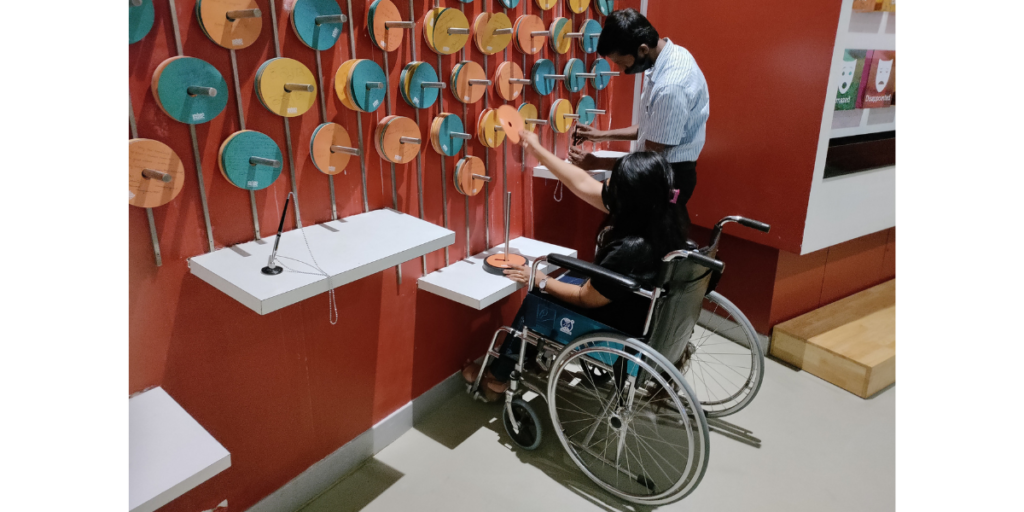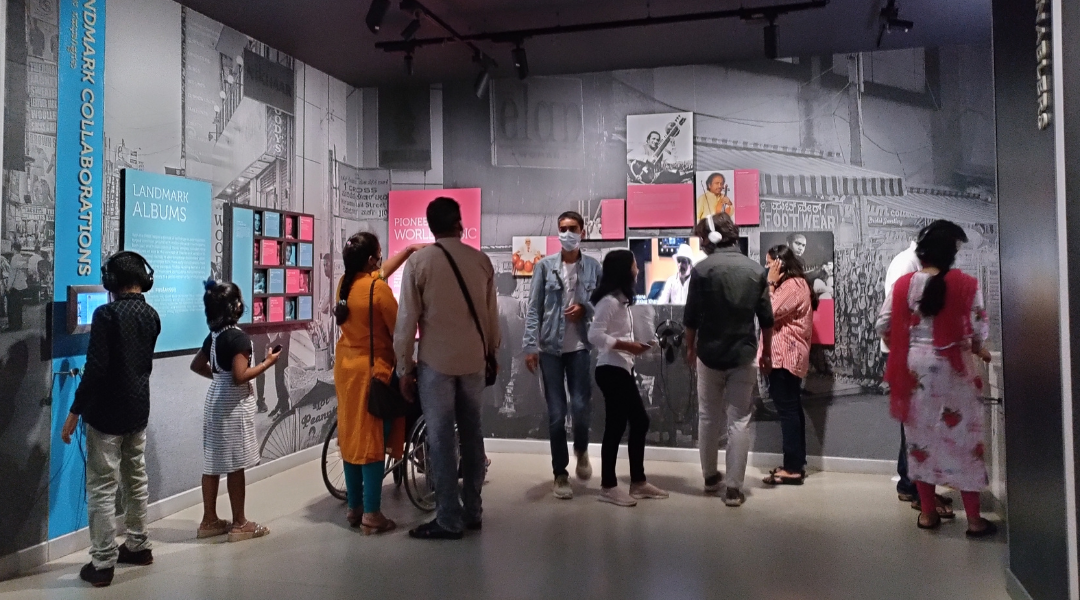During the summer break of 2021, I had the opportunity to intern with ReReeti Foundation, working on Project Svaritha for the Indian Music Experience (IME) in Bengaluru, to design an immersive musical experience for children with neurodiverse needs and children from socially disadvantaged backgrounds. These groups face systemic discrimination and lack of exposure, placing them at a disadvantage compared to the more privileged, especially in accessing museum spaces. The goal of the project was to survey the museum in its present state and provide a list of recommendations based on ideals of inclusion, accessibility, and universal design principles. The ultimate museum experience was envisioned to be relatable and enjoyable for all children, catering to different sensory needs, learning difficulties, social and educational backgrounds, and different levels of exposure to music.
Guided by a team of researchers and consultants who specialise in working with children in these target groups, my initial task involved collecting secondary data on inclusive museum policies. The focus was on projects that involve children with various special needs and those from socially disadvantaged communities. It was disappointing to learn that most of these reports were based in western nations, nonetheless this secondary research provided some guidance for our project. The lack of material provided the opportunity for ours to be one of the first studies exploring what music and museums meant for these children, and the potential that museums in India had in engaging with them meaningfully.
One of the consultants in our team emphasised that the process of research was as important as the research itself. This meant that a study on inclusion had to be inclusive at its outset by directly involving the target groups we hoped would benefit from this project. The team approached various schools and organisations that worked directly with children having different learning needs (such as those diagnosed with intellectual disabilities and children on the spectrum of Autism) and children from socially disadvantaged backgrounds for their consent to participate in the project. Detailed surveys, interviews and focus group discussions were conducted in the local language of Kannada and English for the children and their caregivers. Along with this, inputs were gathered from special educators, care home administrators, and other experts. These inputs enhanced our vision for the experience to be safe and welcoming, interactive, allowing for choice, exploration and experimentation. In its essence, the design aimed at curating a fun outing that would leave the children with a positive memory that they might take forward with them.

My participation in this project has made me critically think about art, academia, and museums. Perhaps most strongly, it has made me very aware of the importance of accessibility and inclusion in today’s world, pushing me to look beyond physical accessibility for persons with disabilities to recognise other barriers. Visitors with different learning needs may not be able to comprehend the information presented, while those with sensory needs may be disturbed by the environment’s overwhelming sensory inputs. Social identities like caste, class, language, region, gender, sexuality, and even age influence formation of cultural and social capital. This in turn determines access to museums and the skills required to navigate it meaningfully. Biases and prejudices from museum staff can also make the space unwelcoming to many visitors.
As public places, museums offer a chance to share information and knowledge that is otherwise restricted within the domain of elite academia, in a less textual and more interactive format. They also serve as a space for diverse populations to mingle with each other. Unfortunately, cultural spaces like museums and galleries are predominantly elitist, especially in India. They cater to a group that has the cultural and social capital to access and afford the entrance fees of physical museums and navigate them with ease. While digital collections don’t require physical travel, access to them still hinges on resources such as stable internet connections.
Art, culture and the right to recreation should not be restricted to a particular section of society. Everyone should have the opportunity to participate in the creation of art, to feel a sense of wonder, curiosity, and the desire to learn more. This is something that this study’s team feels strongly about, and which I believe holds universal value. When marginalised groups whose public presence is seldom acknowledged are enabled to occupy these spaces, their visibility serves as an assertion that they are members of our society as well, and deserve as much space within it as others. Creating safe spaces for those who would otherwise be marginalised in public places is a small but crucial step in developing a society that is inclusive of all. Globally there has been greater recognition of this aspect.
As a student, I was nervous and excited about being a part of this research project. I’ve always liked museums but could never figure out why I thought they were cool. But this whole experience has taught me that museums in India have so much untapped potential. As the world is striving to be more democratic, museum practices should also reflect this. If museums are meant to be for the public, they must involve meaningful participation of all the kinds of people that make up a diverse public. To do so, museums can actively involve local communities and those from various backgrounds in their processes of employment, design, and curation, enabling an environment that welcomes them on their terms. Participation from different groups also provides the chance to learn from communities, and to develop museums which present multiple narratives and perspectives. This helps audiences understand the complexities in their shared histories and cultures. By implementing policies in a manner that brings in visible changes in their practices, museums can become a part of the larger movement to make society more accessible and inclusive for everyone. And I think that’s pretty cool.
Find out more about this project here.
Read the snapshot reports of our findings, here.
K Nitya Devayya is currently an undergraduate student at Ashoka University. While she is open to the possibilities of pursuing different pathways in the future, she is interested in history, museums, archaeology, and heritage. She wants to explore their engagement with society and in ways to bridge the gaps between academia and the general public.








Recent Comments